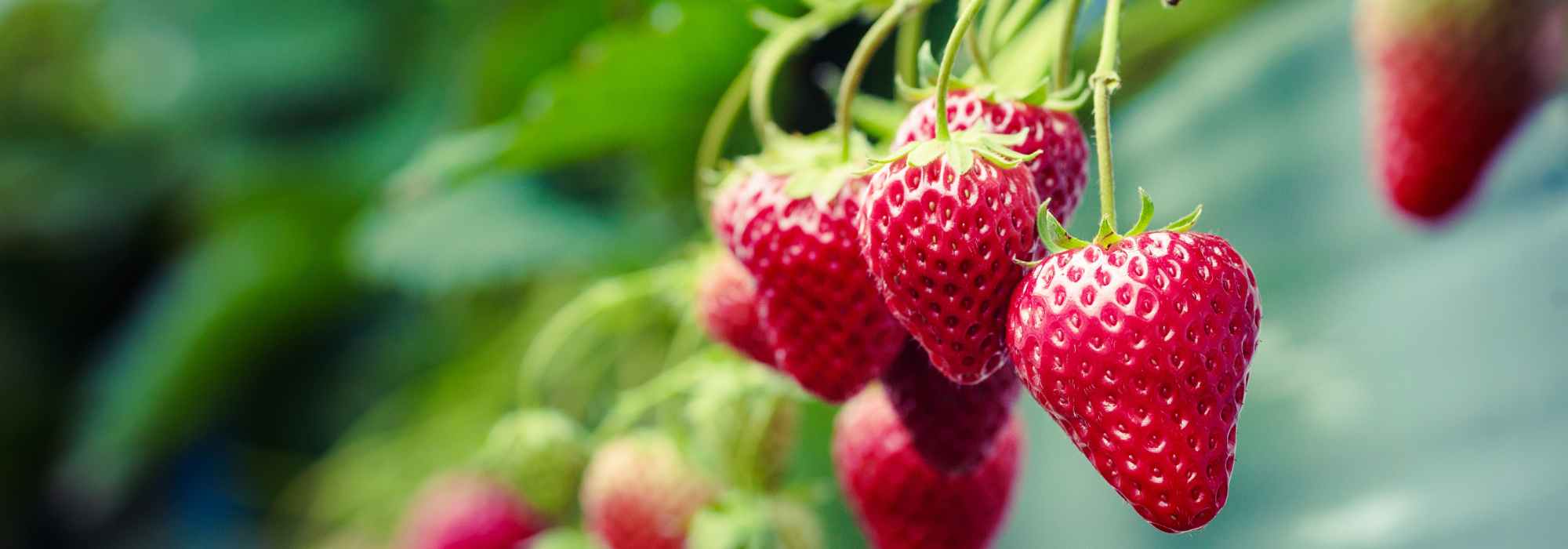
Berries and small fruits to grow in pots
Our selection of berries to grow on a balcony
Contents
Many of us enjoy small fruits and berries such as raspberries, strawberries, blackcurrants, and blueberries, often referred to as red fruits or those classified as berries. However, some of us, without a garden, may hesitate to start growing them. Yet, it is entirely possible to cultivate small fruits on a balcony or terrace. Some compact varieties thrive very well in pots or containers.
Let’s explore these small fruits for small spaces! Perfect for enjoying on the balcony as soon as the warmer days arrive…
Berries in pots: benefits and key considerations
Benefits
Growing small fruits on a balcony or small terrace saves space compared to traditional fruit trees. Besides being both ornamental and edible, cultivation is also much easier, especially with raised containers. They are also generally less attractive to birds than those planted in a garden!
Key Criteria
Horticultural research has specifically developed many compact varieties for container growing. A dwarf habit is therefore essential, especially on very small balconies.
In pots, plants—and particularly fruit-bearing ones—are less resistant to winter cold or winds, which are often stronger at higher building levels. Only the hardiest varieties should be planted to overcome this drawback.
Finally, opt for self-fertile varieties, as in a confined space with limited cross-pollination, these will ensure the best yield.
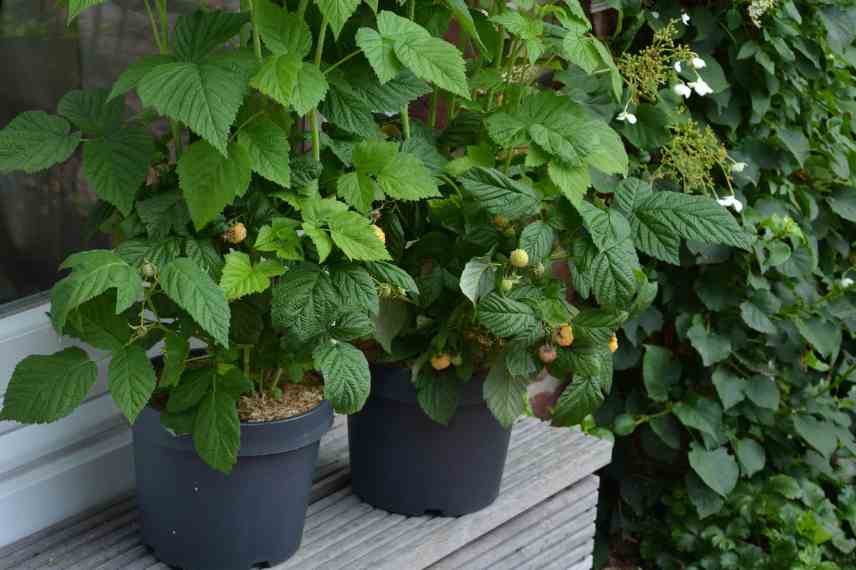
Small raspberry bushes thrive perfectly here on a windowsill
The best strawberry varieties for pots
The queen of balconies, the strawberry is THE fruit you can grow in a small space, planted in containers or pots. Not only is it beautiful to look at through the window as soon as it turns red, but it is often planted in pretty strawberry pots or cascading from hanging baskets.
Prefer, like all the fruits in this selection, an everbearing variety.
Our selection: the ‘Rainbow Treasure‘ strawberry, the Alpine strawberry ‘Yellow Wonder’, as well as ‘Reine des Vallées’, small, very tasty strawberries with the delightful flavour of wild strawberries.
Growing and care:
- Containers vary for strawberries, allowing them to be beautiful features on a terrace or a productive balcony (strawberry pots with multiple openings, planters, hanging baskets). Always choose containers with drainage holes!
- For the substrate, potted strawberries require rich compost and, during the season, regular fertiliser, as they are heavy feeders.
- The ideal exposure for potted strawberries is full sun or partial shade, depending on the region (a south- or west-facing balcony or terrace): this is the key to sweet, well-flavoured fruit.
- Watering should be consistent in summer, to prevent the soil from drying out. Mulching is even recommended, much like in a vegetable garden, but using materials such as miscanthus mulch.
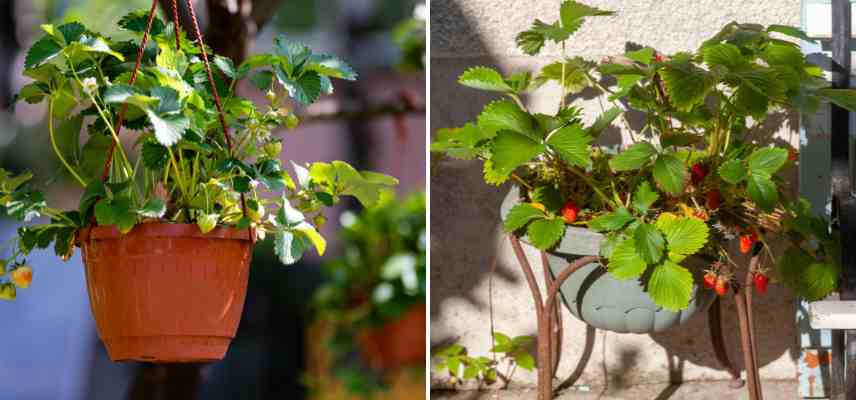
In hanging baskets, on a tripod or in pretty pottery, strawberries are ideal for starting your small fruit production on a balcony
The best blueberry bushes for pots
Blueberry bushes, often considered tricky to grow due to their need for acidic soil, are the perfect berries to cultivate in pots, as it allows better control over their ideal growing medium. Let’s not forget their second asset in autumn, when they become ornamental with their stunning red hues! Here, we look for the most compact, even dwarf varieties among the many cultivars available, and of course, those that guarantee a bountiful summer harvest. Here are our top recommendations:
- ‘Blue Crop‘ for a mid-summer harvest, with medium-sized fruits
- ‘Blues Brothers‘, which produces large, tangy, and juicy berries from late June
- ‘Lucky Berry’, a dwarf variety (70 cm tall in pots), self-fertile, producing from July to September.
Growing and care:
- Use genuine ericaceous compost, mixed half-and-half with good potting soil in a container at least 40 cm in diameter.
- Place your pot in partial shade, with enough sunlight for fruiting (west-facing exposure is ideal)
- Water generously in dry weather, as potted blueberry bushes dry out faster and need consistently moist soil.
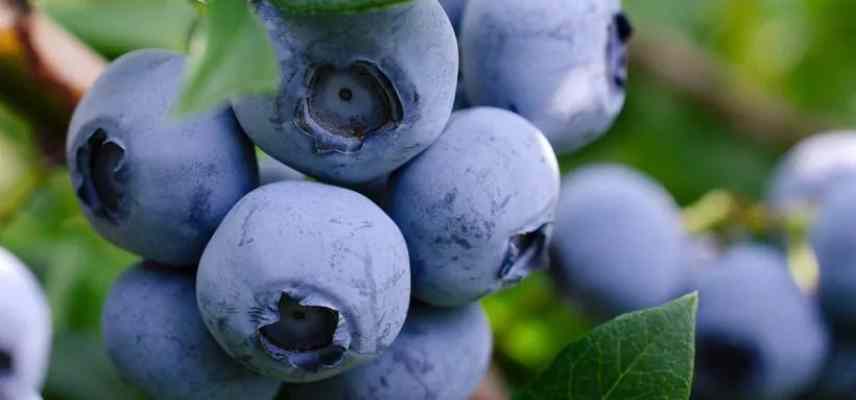
Dwarf blueberry ‘Lucky Berry’
The best blackcurrant bushes for pots
Blackcurrants delight lovers of small black fruits, summer jellies, and sorbets! For balconies, they work well as long as you choose medium-sized blackcurrant bushes, reaching about 1.30m in height. Their pretty foliage and white spring blooms also bring greenery to small spaces, adding a rustic touch, and their leaves can be used to flavour liqueurs.
Here are our favourites for balconies and terraces:
- ‘Little Black Sugar’: compact, self-fertile, appreciated for its early harvest from June
- Blackcurrant Delbard Robusta for a mid-summer harvest, with large, fragrant berries
- ‘Perles d’Auvergne’: an early variety, allowing harvest from June
- ‘Black’n Red Première’, also valued for its purple foliage, ideal for adding colour
- ‘Titania’, with generous fruiting and a mildly tangy flavour.
Growing and care:
- Use a large enough pot: at least 30cm in diameter, with an essential drainage layer (clay pebbles or gravel), as with all potted fruit bushes. Plant it alone in its pot.
- Exposure: in full sun or partial shade, preferably in southern regions.
- Fertilisation: it’s also a hungry plant. Provide a potassium-rich fertiliser (the ‘K’ in NPK on packaging).
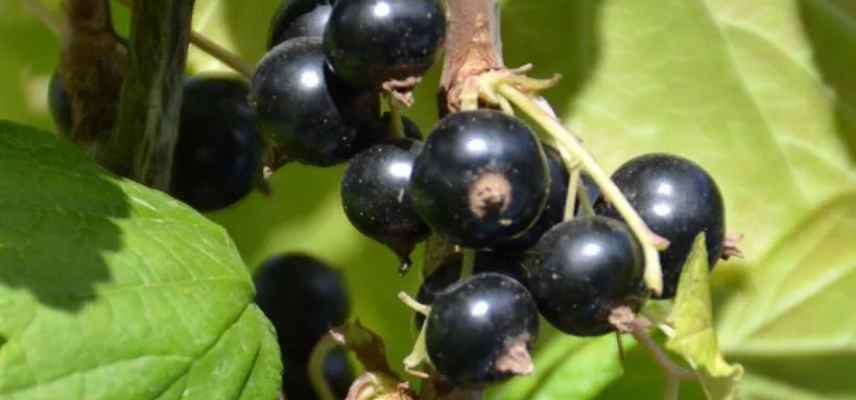
Blackcurrant ‘Perles d’Auvergne’
The best mulberry trees for pots
Just like raspberry bushes, blackberry bushes are primarily thought of as being planted in the ground due to their vigorous growth. We often picture tall, sometimes even invasive blackberry plants in the garden. However, some varieties are well-suited for growing in pots, remaining much more compact. Here are our favourites:
- ‘Black Cascade‘: a recent thornless variety with large, juicy fruits from August to September and a very sweet taste
- ‘Little Black Prince‘: perfectly suited for the smallest spaces, as it is ultra-compact (50 cm in spread)
- ‘Buckingham Tayberry‘, a tayberry, a hybrid between raspberry and blackberry!
Growing and care:
- A large pot with a minimum diameter of 50 cm, otherwise the blackberry won’t thrive
- Exposure: full sun, or partial shade if you live in southern France
- Good mulching will benefit it in the southern half of France.
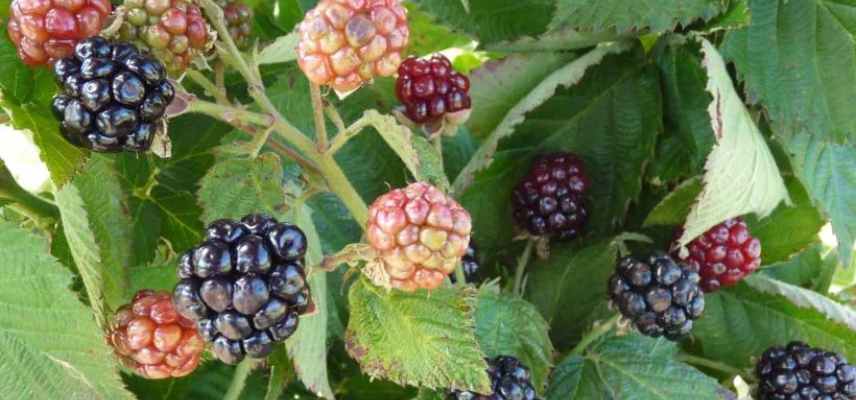
Blackberry ‘Little Black Prince’
The best currant bushes for pots
Redcurrant bushes are best suited to temperate regions, as they will struggle with excessive heat if planted in pots in the south, as they dislike intense warmth.
For small balconies and terraces, gooseberry bushes are quite adaptable and worth (re)discovering, as they are more compact than redcurrant bushes. Their vibrant green hue adds a charming, slightly bohemian touch to balcony spaces. Among the best gooseberry varieties for container planting, consider ‘Lady Sun’.
That said, there are a few dwarf and bushy cultivars among redcurrants, such as the ‘Agate Rouge’ redcurrant by Georges Delbard, which flowers very late in the season.
Growing and care:
- A pot with a minimum diameter of 30-40 cm. The larger the container, the better the redcurrant bush will produce fruit.
- Exposure: Preferably partial shade, except in northern regions.
- Fertilisation: Like many pot-grown fruit bushes, feed them nutrients in spring with a fertiliser for berries.
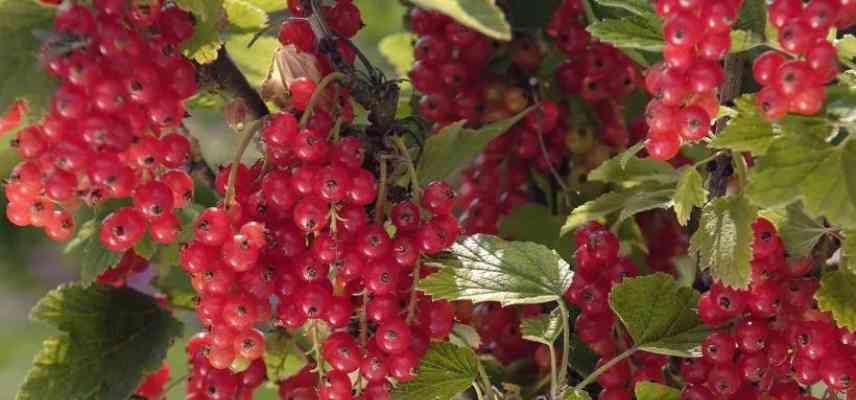
Dwarf redcurrant ‘Agate Rouge®’
The best raspberry bushes for pots
Due to their suckering nature, raspberry plants are often discouraged for container growing. However, new varieties challenge this notion, with some proving well-suited to urban planting or small terraces. Still, opt for a larger container than those recommended for other small fruits mentioned in this article.
- ‘Little Red Princess‘ is ideal for families—thornless and fruiting in August
- ‘Ruby Beauty‘: a non-repeating variety but promises a generous single harvest
- Dwarf raspberry ‘Lowberry Goodasgold‘ produces yellow, mildly tart berries
- Dwarf raspberry ‘Little Sweet Sister’ is sweet and also thorn-free.
Growing and care:
- Choose a sufficiently large pot, at least 50 cm in diameter.
- Exposure: select a partially shaded spot on the balcony. North of the Loire, they can tolerate a sunnier terrace or balcony. Given their spreading habit, position them against a balcony partition for a lush green display.
- Watering: be cautious with container-grown raspberries, as they dislike excessive moisture!
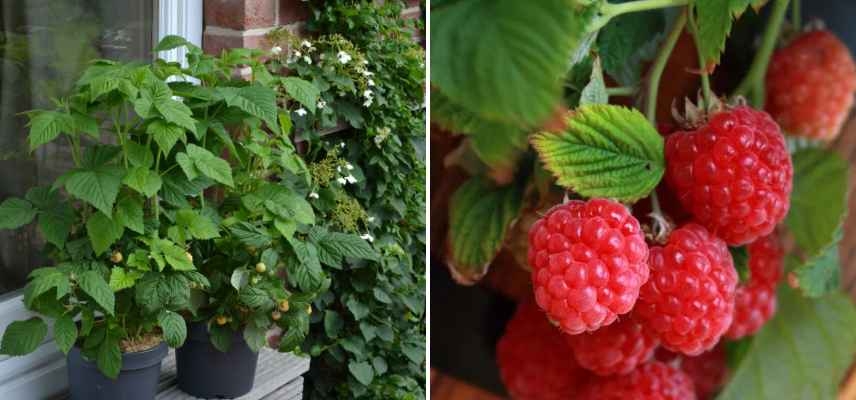
On the right, the ‘Ruby Beauty’ raspberry
Vines and kiwis for pots? It's possible!
For larger terraces, it’s still possible to consider growing kiwis or a small vine, provided you choose ultra-compact varieties. These fruit-bearing plants, true lianas, will nevertheless be less productive than when planted in the ground, and they will only thrive in large containers.
The female kiwi ‘Monty’ and the Kiwi arguta ‘Super Issai’, which are self-fertile, are suitable for container growing. As for vines, we recommend ‘Corniola‘ for its very modest size, growing to a maximum height of 2 metres.
How to successfully grow small fruits and berries in pots?
Good care ensures a bountiful harvest, even in small spaces—don’t forget it! Here are some practical tips for growing and maintaining your small fruits:
The container
This is where your miniature fruit tree will find its nourishment. It should ideally be at least 40 to 60 cm in diameter to provide enough soil and reduce drought stress in midsummer, when most fruits develop.
Also, as with any potted plant, remember to repot your dwarf fruit tree every 2-3 years into a larger container once it has grown well.
The substrate
Rich, well-draining, and acidic for blueberries—choose carefully if you live in the city, prioritising high-quality potting mixes. If possible, add well-rotted compost at planting time. Apply a layer of mulch in spring and during warmer days, essential for balconies and terraces with high exposure.
The ideal exposure
When grown in pots, many berries thrive in partial shade, ideally facing west. In regions north of the Loire, depending on balcony or terrace layout, a south-facing exposure may also work.
Fertilisation
This is one of the secrets to successful berries growing! In pots, the substrate depletes quickly, and your fruit trees have high demands to produce a good harvest. Always fertilise in spring for a vital boost, choosing formulas rich in potassium (tomato fertilisers often work well).
Watering
The substrate dries out much faster in pots. Watering must be consistent from spring to autumn, especially on balconies shielded by overhead cover. Expect to water two to three times a week in midsummer and during heatwaves.
- Subscribe!
- Contents































Comments